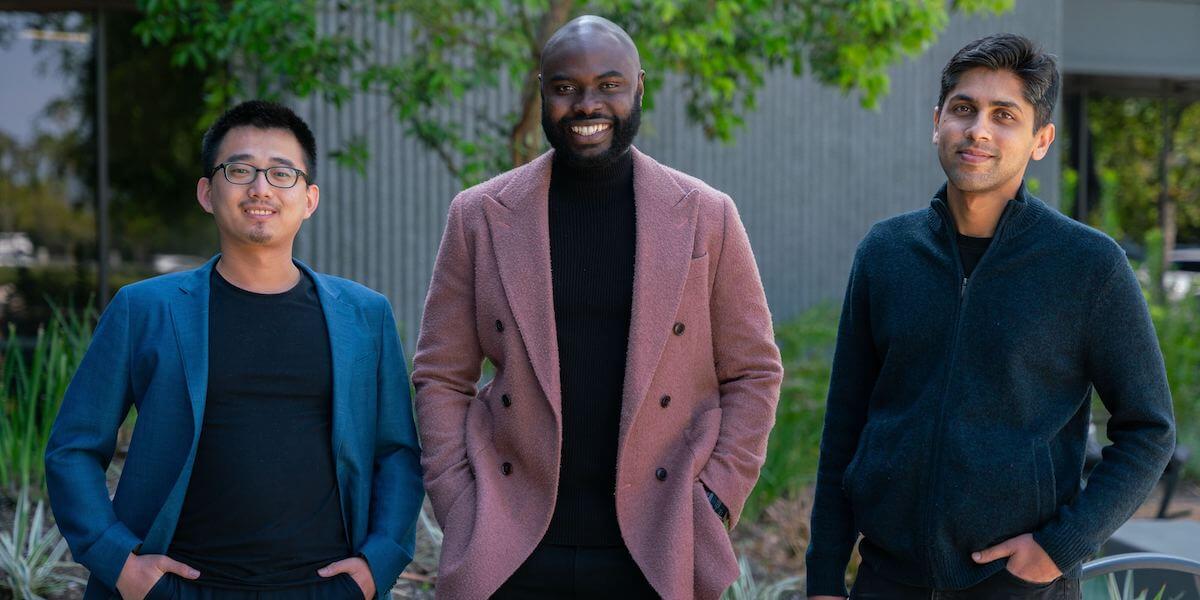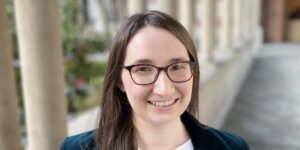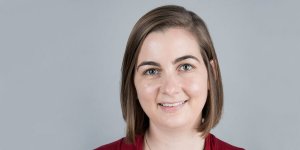
(Left to right) Moving Analytics’ CTO Shuo Qiao, President Ade Adesanya and CEO Harsh Vathsangam (Photo/Courtesy of Harsh Vathsangam)
On Sept. 9, 2021, Harry Holverson experienced a major heart attack that left him short of breath and with acute pain radiating throughout his chest, shoulders arms and neck. The 69-year-old Pittsburgh retiree feared the worst.
“I was just kind of wondering what was going to happen next,” Holverson said. “I worried about another heart attack and if I’d ever be able to ride my bicycle again.”
His concerns quickly dissipated when he began his cardiac rehabilitation with Movn, the nation’s No. 1 virtual cardiac rehabilitation program. Working remotely and intensively for three months with a care manager, a certified exercise physiologist who customized his diet, exercise and medicines, all under the supervision of a cardiologist and other specialists, Holverson’s condition quickly improved.
The retired computer technician said he found the Movn easy to use and intuitive. Once a week, Holverson met with his care manager, via video conferencing through the Movn app, to discuss his progress. Holverson took his blood pressure, weighed himself and exercised daily, entering his results into the app. If he skipped his exercises for a couple of days, Holverson would receive a message of encouragement. If he suddenly gained a couple pounds, his care manager would inquire to see if he was OK.
Today, Holverson said he’s feeling better than he has in years. “I would give Movn an A,” he said. “I’m thrilled with my recovery.” He’s even ready to go on a bike ride again.
Stories like these are what have made the service so popular, said Ade Adesanya, M.S. EMT ’13, president of Moving Analytics. The Irvine-based company, headed by three USC Viterbi alumni, develops smartphone- and tablet-based digital therapies for cardiovascular disease, including Movn.
“Several thousand Americans have used Movn to date, and doubling annually,” Adesanya said. Customers include Kaiser Permanente in Oregon and Washington, Blue Cross-Blue Shield of Illinois, and Veterans Administrations across the country, including Atlanta.
“We’re making a real difference in the lives of patients,” said Harsh Vathsangam, M.S. CS ’10; Ph.D. CS ’13, chief executive officer of Moving Analytics, which has satellite offices in Pittsburgh, Chicago and Atlanta. “When we see them recovering well after a heart attack and hear them say they’re very grateful for our service, it’s very satisfying. At some level, I feel my personal goal of helping somebody lead a better life and live longer is achieved.”
Added Shuo Qiao, M.S. CE ‘ 15, Moving Analytics’ chief technology officer: “We are patient-centered and using technology to help people.”
Heart disease kills
Heart disease is the leading cause of death in the United States, according to the Centers for Disease Control and Prevention, accounting for 25% of deaths. About 18.2 million adults age 20 and older have coronary artery disease.
For those who survive major heart attacks, cardiac rehabilitation cuts the risk of a second heart attack in half, Moving Analytics said. It also reduces hospital readmission rates by 30%, according to the American Heart Association. Cardiac rehab, which includes exercise and lifestyle changes, such as quitting smoking and improving diet, also decreases by 35% the likelihood that a survivor will die in the five years following a heart attack or bypass surgery, the CDC said.
In light of those numbers, it would seem likely that most Americans who experience a heart attack or another major cardiac event would go through rehab. Sadly, that is not the case. For instance, only 25% of eligible Medicare beneficiaries participated in cardiac rehab in 2016 to 2017, according to the American Association of Cardiovascular and Pulmonary Rehabilitation.
Experts offer a myriad of explanations behind the low rates, including high out-of-pocket costs for patients, a paucity of cardiac rehabilitation centers and staff, and a lack of physician referrals. Even patients who begin the rehabilitation process often drop out before completion because they lack the time or energy to drive to a center for three one-hour visits per week over a 12-week period.
Whatever the reason, heart attack survivors and others all too often fail to receive the comprehensive treatment they need, resulting in poor outcomes, including ER visits and even death.
Movn
That’s where Movn comes in.
The telehealth platform for cardiac rehabilitation connects heart patients with a dedicated care manager, often a nurse or an exercise physiologist, who creates a personalized rehabilitation plan lasting three to six months. Doctors and hospitals have access to the Movn portal, allowing them to oversee care.
“We offer a most convenient program that people can do from the comfort of their own home whenever they want,” Vathsangam said, adding that 80% of Movn clients complete their cardiac rehabilitation, a much higher rate than in-person centers. “Movn [users] can even send texts to their care managers, who typically answer within 24 hours or sooner.”
In creating the Movn service, Moving Analytics sought to emulate what company executives consider the nation’s premier home-based cardiac rehabilitation program, Stanford University’s MULTIFIT. The company subsequently licensed MULTIFIT’s research and treatment protocols for caring for patients who had a recent heart attack or heart surgery.
“The Movn service also lowers costs for patients and health insurers,” Vathsangam said.
That’s because people using it have fewer in-person doctor visits and co-payments. They also spend less on gas going to and from cardiac rehabilitation centers, Vathsangam said. Insurers save in two ways: Telehealth rehab costs less than in-person care; Movn also leads to better health outcomes because of higher patient rehab completion rates. That means fewer expensive hospital readmissions that cost $20,000 to $30,000 per visit.
The seven-year-old, 36-employee company has raised over $20 million but expects to land several million more in the near future.
“Moving Analytics was our third investment, roughly three years ago, and the team has continued to be the market leader for digital cardiac rehab,” said Henri Pierre-Jacques, managing partner of Harlem Capital. “More doctors, patients and providers are requesting access to digital capabilities, and Moving Analytics is well positioned to capture this expanding market.”
Born at USC Viterbi
Working with academic adviser Professor Gaurav Sukhatme – the Fletcher Jones Foundation Endowed Chair in Computer Science – Vathsangam wrote a dissertation about using machine learning to accurately characterize physical activities and to design data-driven interventions based on sensed information that won a coveted Ph.D. Achievement Award.
Even as he pursued his graduate studies, Vathsangam said he had the entrepreneur bug. He wanted to create something in the field of healthcare but didn’t know what. Vathsangam figured that he would somehow leverage the technical knowledge he had acquired at USC Viterbi, including a deep understanding of data analytics and sensors.
Vathsangam, who had built some digital tools to track people’s exercise patterns as part of his thesis, soon put together a team to develop a marketable idea. He and Sukhatme cofounded what would become Moving Analytics. Vathsangam then tapped his friend Qiao, at the time a USC Viterbi student from China whom Vathsangam had befriended during their time together at Indian Institute of Technology Madras. Vathsangam later joined forces Adesanya, whom he had gotten to know while the Nigerian native worked at the USC Stevens Center for Innovation.
After nearly two years of research, the foursome came upon the idea of creating digital therapies for chronic disease management; Moving Analytics was born. [Sukhatme was on the company’s board from 2013 to 2020 and now serves as an adviser.]
The clash of cultures has greatly benefited the company, said Vathsangam, who was born in India but grew up in Qatar.
Because of their cultural sensitivities, the executives hired a translator to create the Spanish, Russian, Mandarin, Vietnamese and Tagalog versions of the Movn app rather than rely on Google Translate, which, they said, sometimes misses linguistic nuances. Additionally, the content slightly differs in some of the apps. For example, the Spanish version focuses on healthy foods that tap into ingredients prevalent in Latino culture.
“Our diversity of thought makes us much more aware in providing culturally competent care,” Adesanya said.
A bright future
Vathsangam said he believes Moving Analytics has positioned itself well for the future.
The widespread adaptation of Zoom and FaceTime during the COVID-19 pandemic has made both insurers and patients far more open to telehealth, he said. Late last year, for instance, Medicare began to cover virtual cardiac care, including Movn.
“At the height of the pandemic, cardiac patients across the country also lost access to rehab centers, which temporarily scaled back care or closed,” Qiao said. “Many in-need patients, particularly those with day-to-day work responsibilities, pivoted to remote options like Movn, and subsequently spread the word about the effectiveness and ease of remote cardiac rehab.”
Going forward, Moving Analytics plans to invest heavily in marketing and advertising to drum up new business. The company also hopes to forge partnerships with insurers in all 50 states by the end of next year, up from 11 today.
More important, Vathsangam said Moving Analytics plans to expand its virtual rehabilitation offerings beyond heart attacks and heart surgery to include peripheral arterial disease and other indications such as heart failure.
The company also expects to expand the size of its staff.
“I am excited about the future because we have a tremendous opportunity to save millions of lives through our service,” Vathsangam said. “If we serve a million patients and each one lives another 10 years, we’ve given back humanity 10 million years of living. Who wouldn’t want to join up for that mission?”
Published on May 4th, 2022
Last updated on November 9th, 2022












